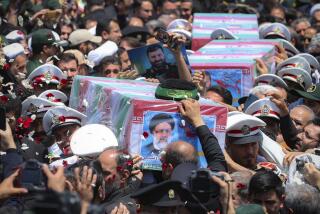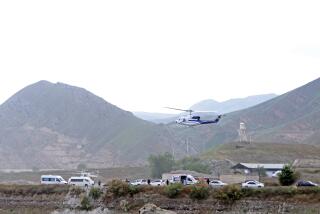Slaying of Afghan Minister Shakes Faith in Government
- Share via
KABUL, Afghanistan — A slain Cabinet minister was buried on a muddy hillside here Saturday, the fog that shrouded his simple wooden casket echoing the cloud of suspicion and intrigue that surrounds his death and threatens to envelope Afghanistan’s fragile peace and struggling government.
The government of interim Prime Minister Hamid Karzai has deemed security its most immediate priority. Yet, disturbingly, the top security officials in the key ministries--interior, defense and justice--have been named as suspects in the airport killing Thursday of Air Transportation and Tourism Minister Abdul Rahman.
Among them are two airport security directors, named as conspirators by Karzai one day after a mob of Muslim pilgrims had been implicated.
If a Cabinet member can be stabbed to death in the very airport that is under his ministry’s control, with hundreds of people milling around to witness it, no government official is safe, observers fear.
Even before Rahman’s killing, few government ministers had dared bring their families back to Kabul, the Afghan capital patrolled by thousands of international peacekeepers. Rahman certainly had not.
Six British peacekeepers in the capital returned fire after they were fired upon Saturday, their commander said, and a person later was found dead nearby. A group of Afghan civilians said a man was killed when they were shot at near a peacekeepers’ post, but it was not clear whether the incidents, or even the posts, were the same.
At least four of the six suspects Karzai named are Tajiks from the Panjshir Valley, who make up the most powerful arm of the Northern Alliance that helped defeat the Taliban. Panjshir natives run the key security agencies, a source of resentment for some ethnic Pushtuns in Karzai’s Cabinet who reportedly have alleged that the Panjshir officials are running a shadow government. Karzai is a Pushtun, the country’s dominant ethnic group, and has said the slaying was the culmination of a long-running political feud.
Karzai’s delicate position could be read in the lineup of mourners at Rahman’s funeral on a hillside left slick by an all-day rain. The prime minister was flanked by the leaders of the ministries whose top security officers have been implicated in Rahman’s death: Interior Minister Younis Qanooni and Defense Minister Mohammed Qassim Fahim, both Tajiks.
Unlike a U.S. president, Karzai did not name his Cabinet. His interim government was the result of an agreement reached in Germany. Now that Cabinet lies at the heart of his biggest crisis since he took office Dec. 22.
Karzai has struggled to root out rogue elements from the government while trying to prevent the kind of bloodletting and factionalism that left thousands dead and the country in ruins in the early 1990s, when the Northern Alliance was in power.
Karzai told the mourners Saturday that Rahman’s killing “was a reminder of past tragedies.”
Particularly significant was the arrest of Gen. Deen Mohammad Joorat, the No. 3 official at the Interior Ministry, who has been accused of arresting and beating political opponents. Mohammed Faqir and Abdul Rahim, both airport security directors who work for the Interior Ministry, also were arrested in connection with Rahman’s killing.
Three other security officials--Panjshir natives from the defense, interior and justice ministries--are being sought in Saudi Arabia. They allegedly fled Afghanistan on a chartered flight of pilgrims headed for the annual hajj to the holy city of Mecca.
The scandal widened Saturday, with more arrests made, Foreign Ministry spokesman Omar Samad said, and more expected. There were unconfirmed reports, denied by Samad, that many others had been arrested for plotting a coup.
It was freezing and pitch black at the decrepit Kabul airport when Rahman was stabbed to death Thursday evening. With no electricity, there was not a single light on the runway or in the terminal building. A crowd of thinly clad Muslim pilgrims, bound for the holiest event of their lives and enraged at 48-hour flight delays that had kept them grounded, had been blocking the path of the India-bound plane carrying Rahman. They threatened to set it ablaze.
Somehow, the minister wound up on the ground and ended up dead. Though his death was initially attributed to a beating at the hands of the angry pilgrims, Rahman actually had been stabbed to death, relatives said Saturday at his funeral.
The plot seems right out of a novel, with elements of murder, shifting loyalties and misdirection. Adding to the intrigue, in previous governments, the Air Transportation and Tourism Ministry controlled a potentially lucrative source of cash from the smuggling of gemstones and heroin on planes, making it a sought-after post.
Adding to the inexplicable chain of events, Karzai was at the airport just an hour before Rahman’s killing.
Samad said Karzai, arriving on a flight from the eastern city of Jalalabad, was confronted by the angry pilgrims and promised that their chartered flights to Mecca would leave soon.
Rahman planned to continue on from New Delhi to Montreal to attend a meeting on airport security.
Also aboard Rahman’s plane were 21 Foreign Ministry employees, headed to India for educational training, Samad said. As the crowd milled around on the runway, the plane’s engines were turned off and the passengers huddled in the back, the midafternoon daylight gradually fading into darkness.
Sometime after 6 p.m., Rahman finally answered the pilgrims’ appeal to address them and headed to the front of the plane, Samad said. Whatever happened to the minister took place either in the front of the plane or outside it, Samad said, but his body ended up on the ground. He was taken to a military hospital, where he died.
Rahman, 49, a doctor and a Tajik, although not from the Panjshir area, had once been a favorite of the late Ahmed Shah Masoud, who commanded the core of the Northern Alliance movement. In the early 1990s, Rahman served his first term as the air transportation and tourism minister in Kabul.
But he and Masoud had a falling out, and he shifted his allegiances to the former king, Mohammad Zaher Shah, who lives in exile in Rome. Three years ago, Rahman moved with his family to India.
Female employees at the Air Transportation and Tourism Ministry, draped in black shawls, came in a separate bus from the male workers to pay their respects at the two-story concrete house where Rahman had lived since his return to his homeland. His four children and two wives (multiple wives isn’t uncommon in Afghanistan) didn’t attend: One wife lives in India, the other in Germany, relatives said.
Sport-utility vehicles and pickups ferried government officials and Northern Alliance commanders and soldiers to the burial. As soldiers stood sentry on the mountains flanking the cemetery, Rahman’s casket was lowered into the earth.
More to Read
Sign up for Essential California
The most important California stories and recommendations in your inbox every morning.
You may occasionally receive promotional content from the Los Angeles Times.














